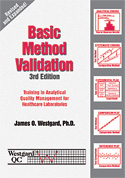We also encourage our visitors to get the latest, most up-to-date information on Method Validation in the third edition of the Basic Method Validation manual and the Basic Method Validation online course.

| Please note: These tools use "pop-ups" to display
the results of your entered data. If you have a browser that blocks
pop-up windows, you may not be able to see any graphs. Also, we
recommend using Firefox or Opera browsers. Internet Explorer browsers,
particularly earlier than version 6, may not correctly display the
graphs.
We also encourage our visitors to get the latest, most up-to-date information on Method Validation in the third edition of the Basic Method Validation manual and the Basic Method Validation online course. |
 |
· Linear-data plotter can be used with data from a linearity experiment to assess the reportable range of a method. It provides a plot of the average of a group of replicate test results on the y-axis versus the assigned value (in % or concentration units) on the x-axis. · SD Calculator can be with data from a replication experiment to calculate the mean, standard deviation (SD or smeas), and coefficient of variation (CV). A histogram display of the data is also available. · Paired-data Calculator can be used with data from a comparison of methods experiment to calculate linear regression statistics (slope, y-intercept, and standard deviation about the regression line, sy/x), and the correlation coefficient (r, Pearson product moment correlation coefficient); t-test statistics (average difference between two methods or biasmeas; SDdiff, standard deviation of the differences between the two methods). It can also be used to provide a "comparison plot" that shows the test method results on the y-axis versus the comparative method results on the x-axis, as well as a "difference plot" that displays the difference between the test minus comparative results on the y-axis versus the comparative method result on the x-axis. · Method Decision Calculator. This tool has been de-activated. An updated tool can be accessed at theWestgard course portal . For those who prefer not to pay for access, you can still download a Six Sigma Method Decision spreadsheet. |
